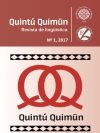Clíticos marginales en verbos denominales en -ear / Marginal clitics in denominal verbs ending in -ear
Main Article Content
Abstract
El fenómeno de los clíticos marginales ha sido estudiado en distintas lenguas romances y en lenguas como el griego moderno (Spitzer 1941, Bibis & Roberge 2004, Espinal 2009, Leivada & Grohmann 2014, entre otros). En español rioplatense, el clítico marginal la ocurre de manera productiva en verbos como zurdearla, kirchneriarla y hipiarla, preferentemente en un registro informal. A diferencia de los casos estudiados en la bibliografía, se trata de un patrón morfológico y semántico recurrente, [Npredicativo/modal-ear-CLmarginal.Acc.fem.sg]Verbo. Nuestro objetivo en este trabajo es describir el comportamiento sintáctico y semántico de los verbos de la forma [Npredicativo/modal-ear-CLmarginal.Acc.fem.sg]Verbo. Para ello, partimos de la hipótesis de que los verbos estudiados no forman expresiones idiomáticas, sino que se trata de un fenómeno productivo, de significado composicional. Nuestro análisis está basado en las propuestas neoconstruccionistas, en el marco de la gramática generativa, según las cuales las estructuras sintácticas se forman a partir de la combinación de núcleos funcionales y raíces gramaticalmente opacas, lo que da lugar a significados composicionales y predecibles.
Palabras clave: clíticos marginales, morfema -ear, verbos inergativos, español rioplatense
ABSTRACT
The marginal clitics phenomena have been studied in several Romance languages and languages like Modern Greek (Spitzer 1941, Bibis & Roberge 2004, Espinal 2009, Leivada & Grohmann 2014, among other authors). In Rioplantense Spanish, the marginal clitic la (3.sg.Acc.fem) occurs productively in verbs such as zurdearla (‘left-ear it’), kirchneriarla (‘Kirchner-ear it’) y hipiarla (‘hippie-ear it’), principally in informal register. In contrast to the cases studied in the literature, this is a recurring morphological and semantic pattern, i.e., [Npredicative/modal-ear-CLmarginal.Acc.fem.sg]Verb. The aim of this paper is to describe the syntactic and semantic characteristics of [Npredicative/modal-ear-CLmarginal.Acc.fem.sg]Verb verbs. In order to do this, we postulate the following hypothesis: the verbs studied are not idiomatic expressions but productive phenomena whose meaning is compositional. Our analysis is based on neo-constructionist approaches, in the Generative Grammar framework. These theories propose that all syntactic structures are built by combining functional heads and grammatically opaque roots, which gives rise to compositional and predictable meanings.
Keywords: marginal clitics, -ear morpheme, unergative verbs, Argentinean Spanish
Downloads
Article Details
Los autores de los artículos publicados conservan los derechos de copyright.
Licencia de uso:

Creative Commons Atribución-NoComercial-CompartirIgual 4.0 Internacional.
References
Acedo Matellán, Víctor (2010) Argument Structure and the syntax-morphlogy interface. A case study in Latin and other languages. Tesis de doctorado. Universitat de Barcelona.
Bibis, Nick (2002) The Syntax of Clitics in Idiomatic and Other fixed Expressions. Tesis doctoral. Universidad de Toronto.
Bibis, Nick & Yves Roberge (2004) Marginal clitics. Lingua 114: 1015-1034.
Borer, Hagit (2005a) In name only. Oxford: Oxford University Press.
Borer, Hagit (2005b) The normal course of events. Oxford: Oxford University Press.
Di Sciullo, Ana María & Edwin Williams (1987) On the Definition of Word. Cambridge, MA: MIT Press.
Espinal, María Teresa (2009) Clitic incorporation and abstract semantic objects in idiomatic constructions. Linguistics 47.6: 1221-1271.
Fábregas, Antonio & Soledad Varela (2006) Verb clases with eventive infinitives in Spanish. En Sagarra, Nuria & Almeida Toribio (eds.) Selected Proceedings of the 9th Hispanic Linguistics Symposium. Somerville, MA: Cascadilla Proceeding Project. 24-33.
Halle, Morris & Alec Marantz (1993) Distributed Morphology and the pieces of inflection. En Hale, Ken & Jay Keyser (eds.) The View from Building 20. Cambridge, MA: MIT Press. 111-176.
Kany, Charles (1945) Sintaxis hispanoamericana. Madrid: Gredos.
Keniston, Hayward (1937) The Syntax of Castilian prose. The Sixteen Century. Chicago: The University of Chicago Press.
Leivada, Evelina & Kleanthes Grohmann (2014) Clitics in idioms: Properties of morphosyntax and reference. Lingua 150: 45-70.
Marantz, Alec (1995) Cat as a phrasal idiom (ms.). Cambridge: MIT.
Martín García, Josefa (2008) Verbos denominales en –ear: caracterización léxico-sintáctica. Revista Española de Lingüística 37: 279-310.
Oltra-Massuet, Isabel (2000) On the notion of theme vowel: a new approach to Catalán verbal morphology. MITOPL 19, Cambridge.
Oltra-Massuet, Isabel & Elena Castroviejo (2014) A syntactic approach to the morpho-semantic variation of -ear. Lingua, 151: 120-141.
Pena, Jesús (1993) La formación de verbos en español: la sufijación verbal. En Varela, Soledad (ed.). La formación de palabras. Madrid: Taurus. 217-281.
RAE-ASALE (2009) Nueva gramática de la lengua española. Madrid: Espasa.
Rifón, Antonio (1997) Pautas semánticas para la formación de verbos en español mediante sufijación. Santiago de Compostela: Universidad de Santiago de Compostela.
Spitzer, Leo (1941) Feminización del neutro. Revista de Filología Hispánica 3: 339-371.
Vendler, Zeno (1967) Linguistics in Philosophy. New York: Cornell University Press.
